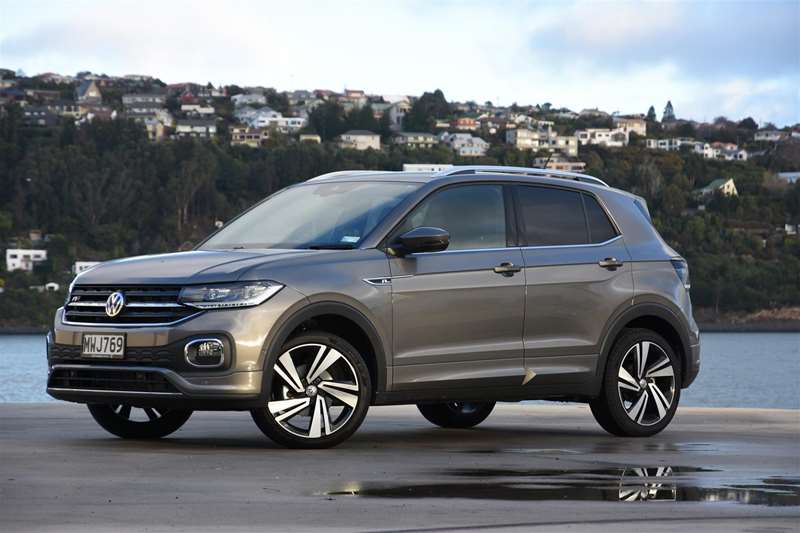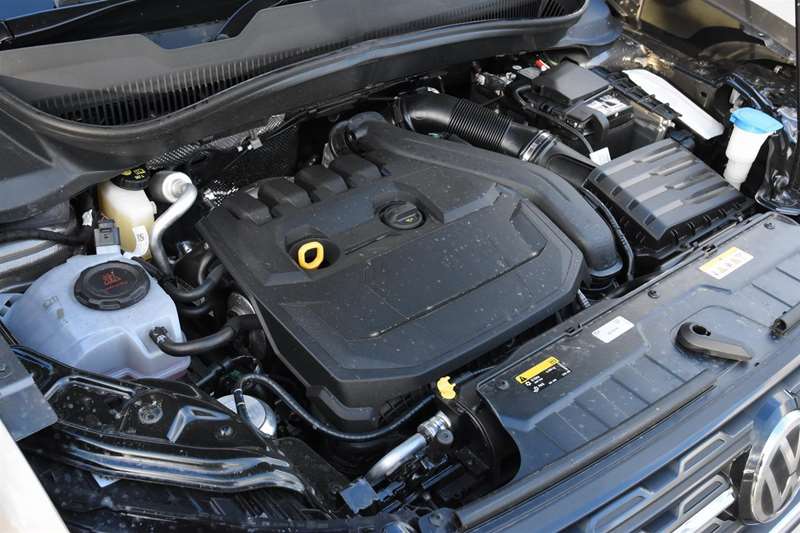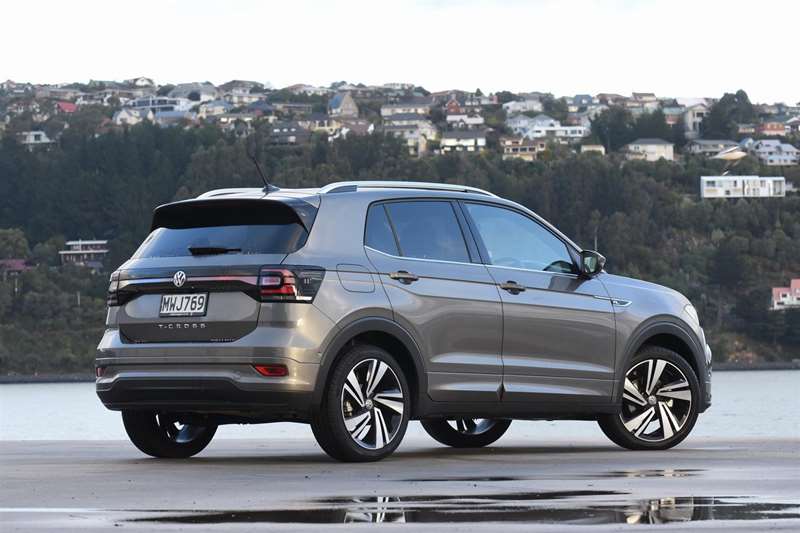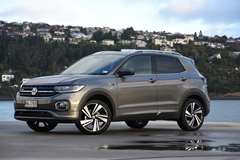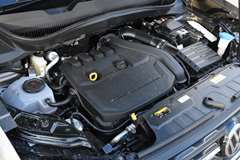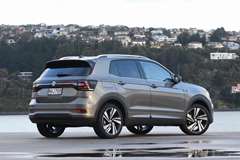Compact crossover SUVs are all the rage just now, and Volkswagen is looking for a slice of action with two recent additions to its local range, the T-Cross and T-Roc. David Thomson tries the smaller of the two, the T-Cross, for size.
What’s new?
In the wider world, Volkswagen’s T-Cross has been around since 2018, but — like its larger sibling, the T-Roc — has only just made it to these shores.
Identical in wheelbase but slightly longer overall than the VW’s Polo hatchback, the T-Cross is a frontwheel drive high-riding crossover hatchback, designed for family friendly life firmly on the beaten track.
New Zealand takes four models, ranging in price from $34,240 for the TSI Life DSG through to $43,490 for the TSI R-Line DSG. Three are powered by VW’s diminutive but lively 85kW/200Nm 1.0 litre three-cylinder turbo engine.
However, the range flagship, as tested, sports a 110kW/250Nm 1.5 litre four-cylinder turbo.
If mention of that engine seems familiar, then perhaps you last read about it a few weeks ago in our test of the T-Cross’s VW Group stablemate, the Skoda Karoq.
The motor is paired with a sevenspeed DSG transmission, powering the front wheels.
What’s it like to look at?
The look is handsomely chunky, with a prominent and bluff nose and a high waistline. This latter feature and its elevated ride height (180mm) provides the T-Cross with a substantial on-road presence that prospective buyers are likely to find reassuring as well as attractive.
The R-Line model, as the range flagship, takes a few extras, including special 18-inch alloys fitted with 215/45 R18 tyres, R-Line accenting on the bumpers and front door sills, a special rear spoiler, projector beam LED headlights with associated LED running lights, silver anodised roof rails and R-Line badging on the front guards.
What’s it like inside?
The T-Cross is VW’s smallest crossover SUV, but due to some clever and flexible interior packaging, it is first-rate by class standards in terms of cabin space.
The key to its flexible interior is the combination of a boot floor that adjusts for height and a sliding rear seat that allows either back seat room or boot space to be prioritised.
Opt for maximum rear seat room and is there sufficient leg space to enable a 183cm-tall passenger to sit behind a same-sized driver, and not feel unduly cramped. Sure, the rear occupant’s knees will brush the back of the driver’s seat, but headroom is fine and remember this is a compactsized crossover.
There is no fold-down centre armrest, and shoulder room is tight across the back for three adults, but fine for smaller people. Isofix child seat anchor points are provisioned for the outboard rear seats (and also for the front passenger’s seat) and two USB charge points are included at the back. My one niggle about the rear seating position was that the high waistline (combined with dark upper trim on the R-Line) might make the rear of the cabin feel quite hemmed in.
Boot capacity ranges from 385 litres with the rear seat fully back, to 455 litres when it is fully forward, or 1281 litres when both parts of the 60:40 split rear seat back are folded flat. The lower of the two boot floor positions maximises space in the main boot cavity, but with a load lip. Fitting the boot floor into the higher position there is no load lip, an out of-sight compartment under the main floor and, if the rear seats are folded down, the load area is flat.
Up front the cabin is spacious and airy. The comfortable and supportive front seats adjust for height. There are good-sized door pockets (as there are in the back), a small centre bin, dual UBS ports beside the tray at the base of the console, a slender glovebox and a storage bin under the driver’s seat.
The R-Line package delivers quite a dark interior with all the main trim in grey or black with dark patterned inserts, and very little chrome or brushed metal. The R-Line seats have contrasting fabrics, with paler patterned inserts and suede-style bolsters and artificial leather sides.
Ergonomically, the front of the cabin is almost spot on, with the main controls and majority of switchgear falling naturally to hand, fine customisable digital instrumentation, a clear and easy to use centre touchscreen and simple and effective smartphone mirroring and Bluetooth connectivity. Two features that jar are the positioning of the handbrake and the pushbutton start on the passenger’s side of the centre console; these are legacy features derived from the T-Cross’ origins as a left-hand-drive vehicle, and it is disappointing VW hasn’t made the effort to correct them for right-hand-drive markets.
What comes as standard?
The R-Line is the only T-Cross model fitted with adaptive radar cruise control, but the safety specification is otherwise standard across the range. Key features include autonomous emergency braking, forward-collision warning, pedestrian and cyclist monitoring systems, lane keeping assistance, blind sport monitoring and rear traffic alert. All T-Cross models are fitted with front and rear parking sensors, reversing camera and parallel parking assist.
Every T-Cross model aside from the base model comes with dual zone climate control, a leather-rimmed multi-function steering wheel with paddle shift controls, satellite navigation, six-speaker audio and voice control for the multi-media system.
What’s it like to drive?
The T-Cross tends to the SUV end of the crossover spectrum in providing an elevated command-style seating position, and this feature alone will endear it to many potential customers. So, too, willthe fact that the T-Cross feels — in a good way — like a larger and more substantial machine than it is.
For those with no need of allwheel drive, the drivetrain is excellent. The 1.5 litre engine combines impressive real world frugality (6.2l/100km ona demanding test, and 5.5l/100km on the standard cycle) withzesty, characterful performance. Supported by its well sorted DSG transmission, the engine’s production of maximum torque from just 1500rpm ensures responsive acceleration at quite light throttle openings, which is handy around town and for open road overtaking.
Working the engine harder (and perhaps engaging sport mode or using the paddle shifts) is rewarding, too.
While handling is certainly not sports-car like, the T-Cross is surefooted and quite fluid and fun in its responses. Steering that is accurate and nicely weighted, ifa little lacking in feel, is an asset in this regard.
The suspension set up combines reasonably soft and absorbent primary springing with relatively assertive damping. As a result, while the test car coped very well when traversing big bumps, the ride became more brittle over smaller, sharper surface imperfections, especially around town.
Noise levels were well contained, albeit with the usual European car issue of tyre roar over coarse-chip surfaces.
Verdict?
Snow is forecast overnight as I complete this road test, which leads me to wonder if four-wheel drive might be a good thing. But if that is not something that unduly bothers you, the T-Cross should hold plenty of appeal. Well-packaged, solid in look and feel, and more fun than you might expect to drive, it’s a worthy additional to VW’s burgeoning SUV and crossover range.
